Surge Fencer Post and Insulator
compiled by Kevin Lawless
Reprinted from "Crown Jewels of the Wire", December 1985, page 24
(excerpt from letter in this article)
...Thank you very much for your inquiry regarding the Surge Electric Fencer and
the Surge Insulators. I will try to answer your questions to the best of my
ability, however, there are very few records to refer to regarding these
products. The insulators and fencer were both designed be a gentleman by the
name of John Schilling around the early 1940's...
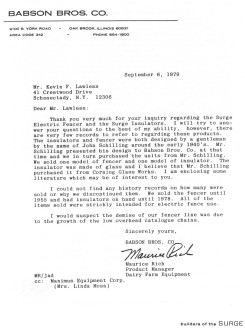
(Medium Image - 69 Kb)
(Large Image - 177 Kb) |
BABSON BROS. CO.
2100 S. York Road -- Oak Brook, Illinois 60521
Area Code 312 -- Phone 654-1600
September 6, 1979
Mr. Kevin F. Lawless
41 Crestwood Drive
Schenectady, N.Y. 12306
Dear Mr. Lawless:
Thank you very much for your inquiry regarding the Surge Electric Fencer and
the Surge Insulators. I will try to answer your questions to the best of my
ability, however, there are very few records to refer to regarding these
products. The insulators and fencer were both designed be a gentleman by the
name of John Schilling around the early 1940's. Mr. Schilling presented his
design to Babson Bros. Co. at that time and we in turn purchased the units from
Mr. Schilling. We sold one model of fencer and one model of insulator. The
insulator was made of glass and I believe that Mr. Schilling purchased it from
Corning Glass Works. I am enclosing some literature which may be of interest to
you.
I could not find any history records on how many were sold or why we
discontinued them. We sold the fencer until 1955 and had insulators on hand
until 1978. All of the items sold were strictly intended for electric fence use.
I would suspect the demise of our fencer line was due to the growth of the
low overhead catalogue chains.
Sincerely yours,
BABSON BROS. CO.
Maurice Rich
Product Manager
Dairy Farm Equipment
MR/jad
cc: Maximus Equipment Corp.
(Mrs. Linda Moss)
builders of the SURGE
|
This may not be very scientific, but it is a simple way to think of electric
fencing.
The Fence Controller (3), charges the Fence Line (2), with a very small
amount of electricity, but you know you can't have an electric current without
two lines, and they have to be connected so the Ground Line (1) serve as as a
second line or return line.
Now, there has to be a connection between the Fence Line (2) and the Ground
Line (1) before you get a flow of electric current.
Here is where the cow comes into the picture. -- She touches her nose or body
to the Fence Line (2), and her feet are on the Ground Line (1). That completes
the circuit -- the electricity flows through the cow, consequently she gets an
electric shock -- she doesn't like it, and backs away from the fence, and very
soon learns to stay away from the charged wire... the Fence Line.
The bird sitting on the fence can sleep there all day -- can't get a shock
because it can't touch the Fence Line and the Ground Line at the same time.
It is obvious from the above that there are three parts to an Electric Fence,
and remember that all three are of equal importance, and you can't have
satisfactory Electric Fence or satisfactory Stock Control without:
- A Good Ground Line
- A Good Fence Line
- A Good Fence Controller
(1) A GOOD GROUND LINE.
A Good Ground Line is one of the three essentials to satisfactory Stock
Control. It is very often neglected, and neglect or careless installation is
often the cause of an unsatisfactory Electric Fence. Start right by putting in a
Good Ground -- it is simple and easy to do -- but you must have A Good Ground.
The ground current is carried through the wet or damp ground, so the ground
rod or ground connection must go down in the earth far enough to connect with
the damp earth where there is moisture, even in the dry months of summer -- usually
6 feet below the surface is sufficient.
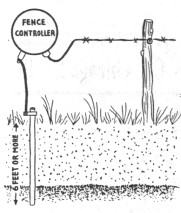
One of the easiest ways to make A Good Ground is to drive a 3/4" piece
of galvanized pipe, 7 feet long, into the ground 6 feet, leaving about one foot
above the ground for convenience in connecting. the ground wire to the fencer.
(A galvanized pipe will last many years without rusting out.)
There are several other ways of putting down a satisfactory ground -- use an
iron rod or piece of bar iron, instead of galvanized pipe -- or dig a 6 ft. hole
and use a piece of copper cable or galvanized cable, but in any case always put
the ground down to permanent moisture.
It is also very important that the ground wire from the fencer is properly
connected with the ground rod or cable.

Scrape or file both the ground rod and the ground wire from the fencer where
they are to be connected, so as to make a good clean electrical connection. --
We advise making the connection with a ground clamp.
NOTE: A Fencer should always have its own separate ground. -- If grounded to
a water pipe it may cause radio interference -- if grounded to a lightning rod
ground there is danger of damage to the fencer. Lightning protection to the
fencer requires direct connection to the damp earth, which is another reason for
a good ground rod running down to permanent moisture. -- If the weather gets
very dry in summer, pour several buckets of water around the ground rod or
ground cable to make sure you have a good connection to ground.
That's all there is to A Good Ground --but you must have it for a
satisfactory Electric Fence or satisfactory Stock Control.
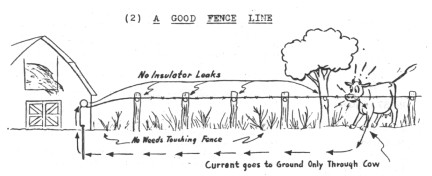
A Good Fence Line is another of three essentials to satisfactory Stock
Control. The Fence Line carries the electric current that shocks the cow, so you
must keep all the electric current on the Fence Line, which means that you must
avoid leaks or short circuits from the Fence Line to the ground. If there are
leaks or short circuits, only a part of the electric current, or possibly none
of it, will be left to shock the cow when she touches the fence, resulting in
unsatisfactory Stock Control.
Leaks and short circuits are caused by only two things:- (1) Weeds or
vegetation growing to sufficient height to touch the Fence Line, thus short
circuiting all or part of the current to the ground. Remedy:- Cut down weeds along
the fence line -- (2 ) Faulty insulators that allow the current to travel down
the fence posts and short circuit all or part of the current to the ground.
Remedy: - Good insulators, properly installed.
INSULATORS -- It is very important that you understand in some detail
the properties and functions of insulators, because a Good Fence Line is dependent
on good insulators properly installed. -- Inefficient insulators are very
frequently the cause of partial or total electric fence failure. -- An insulator
is a non-conductor of electricity that holds the fence wire in place on the
fence post and keeps the current from traveling down the post to the ground.
PORCELAIN INSULATORS are made in many designs and are in too common use,
because porcelain insulators are efficient only as long us the glaze on the
outside is undamaged and free from cracks. The inside of a porcelain insulator
is porous, absorbs moisture, so when the glaze is broken, it is no longer an
efficient insulator. So be on the lookout for cracked or damaged insulators,
which are very often the cause of total or partial failure.
GLASS INSULATORS or the telephone type insulators are far superior to any
porcelain insulator; in fact, it might be referred to as the perfect insulator.
They will be much more widely used as farmers learn by experience the
deficiencies of porcelain insulators, even though the first cost of glass
insulators is higher. The glass insulator is the solution to a permanently satisfactory
fence.
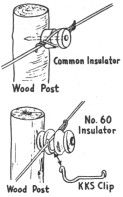
The following are recommendations on several types of insulators and posts
shown in the sketch on Page 4. (Of course no fence would have all these
varieties of insulators and posts.)
COMMON INSULATOR -- This is probably the cheapest insulator you can
buy -- often referred to as a penny insulator -- and it is in far too common
use. If a farmer owns a lot of these insulators, he is going to use them, but
discourage him from buying more. -- Those in use should be carefully inspected
for cracks and for a film of rust from the wire to the nail head... both the
cause of short circuit. -- If used at all, use only on wooden posts, and never
on trees or iron posts. (We never have sold or recommended this type insulator.)
-
#60 INSULATOR -- This is the best porcelain insulator we know of for wood
posts -- but don't use them if they are cracked. This insulator is not
recommended on iron posts or trees. -- It makes a very good corner insulator.
Supplied with double-headed nail and leather washer. Use KKS Clips for
convenience in attaching line wire.

#57 INSULATOR -- This is the best porcelain insulator we know of for steal
posts, and it is the only porcelain insulator we recommend for steel
posts. Use cotter fasteners for convenience in fastening to the steel posts. No
clip is required to hold line wire. (This is also a good insulator for wood
posts if you use a 3-1/2" double-headed nail with leather washer.
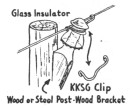
GLASS TELEPHONE TYPE INSULATOR -- This is of course the best insulator
available for wood or steel posts, and is recommended for the entire fence line,
regardless of the kind of post used. Glass insulators mounted on a wood bracket
eliminate all possibility of a leak through a rust film or water film, and are
therefore the most efficient insulators in wet or dry weather. Use KKSG Clips
for convenience in attaching wire. ALWAYS USE GLASS TELEPHONE TYPE INSULATORS
ON TREES.
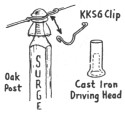
SURGE POST WITH GLASS INSULATOR -- This is a 2" x 2" oak
post, impregnated with pentachlorphenol, pointed for driving, and made with a
screw head for a glass insulator, recommended for all line posts. The SURGE Post
with Glass Insulator eliminates all possibility of an insulator leak, regardless
of weather -- it saves time in putting up an electric fence, because they are
easy to drive -- and they make an attractive fence that anyone will be proud of.
(There is a cast iron driving head that fits over the screw top for convenience
in driving the post.) Use KKSG Clips for convenience in attaching wire.
THE FENCE WIRE carries the current that stops the stock; therefore, every
time you splice the wire it is important that you make a good electrical
connection.

The sketches at the left show the right and the wrong way to make a
connection. We also show a Connector Clip which is sometimes convenient to use
in making connections with smooth wire or barbed wire. Always thoroughly
clean both ends of the wire to be connected, either by scraping or filing.
-- For best results use galvanized wire that is free from rust.
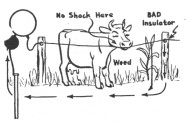
If there is a "short" caused by a bad insulator or a weed touching
the fence, the entire fence on both sides of the "short" is
ineffective, consequently a cow touching the fence on either side of the
"short" (even the side nearer the fencer), will get only a partial
shock or no shock at all. -- Reason, electricity is lazy - it always
takes the course of least resistance, and the short circuit through the fence
post or weed is usually a better ground connection than the cow, consequently
the current goes to ground through the fence post or weed and doesn't shock the
cow.
Why is a Glass Insulator so much better than a porcelain insulator? -- A
porcelain insulator is good when new, and when insulator and post are dry. But a
glass insulator is always good even in wet weather, and here is why:- A
permanent rust film or film of water forms from the wire to the nail and through
to the damp post or steel post or tree, and carries the current to ground -- or
the outer glaze is easily and often cracked and the current passes directly
through the porous portion direct to nail and post to ground.

A rust film will not form from fence wire to nail on this style insulator.
There is better drainage of moisture, and there is not as much danger of a water
film, but there is still some possibility in wet weather of the current carrying
through the water film to the nail down the post and to the ground, and if the
outer glaze is cracked, the current can pass through the porous portion direct
to nail and post to ground. However, it is a much better insulator than the one
shown above.
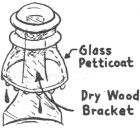
The Glass Insulator prevents all difficulty from a rust film or film of
water. Rust isn't likely to form on a glass insulator, and even if there was a
rust film and a film of water on the outside of the glass insulator, the current
could not get to the post because it can't travel up through the "dry
petticoat" on a glass insulator and it couldn't connect with the wet post,
because the wood bracket where it touches the insulator is always dry, protectad
by the glass "petticoat". -- There can't be a leak where glass
insulators are used. -- You have seen many insulators like this all your
life on telephone poles and power line poles. They cost a little more, but they
are always good insulators.
That's about all there is to A Good Fence Line, but it's very important.
A GOOD FENCE CONTROLLER
A Good Fence Controller takes the current from the power line and cuts it
down to 25 milliamperes, or 1/40th of an ampere -- no more or no less. More
would be dangerous -- less would not stop the stock. -- And the current must be
delivered to the fence in brief shocks with an interval between of sufficient
duration to allow the animal to release itself from the fence. The current or
shock should come on the fence line once a second, with an "on" period
of not more than 1/10th of a second, and an "off" period of at least
9/10ths of a second. -- That is exactly what the SURGE A.C. Fencer does.
The Fence Controller must be made so that there is no possibility that the
interrupting mechanism will fail, or that the insulation and transformer will
break down and connect the power line direct with the fence. It is for this
reason that the design and construction of the Controller must conform to proper
Codes. -- The Department of Agricultural Engineering, Cornell University, in
their Bulletin #539 (copy on request) concludes a paragraph relating to Codes,
as follows:- "Controllers approved by the Wisconsin Industrial Commission
carry tags showing that approval and units so tagged are counted on as being
safe." -- The SURGE A.C. Fencer is built that way, and is approved by the
Wisconsin Industrial Commission.
THE SURGE A.C. FENCER is built to give safe, sure dependable and lasting
Stock Control.
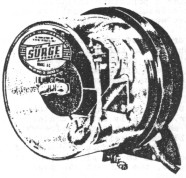
The SURGE Mercury Safety Switch makes it impossible to ever have continuous
current on the fence wire, because the glass tube is curved with electrodes in
the middle. The mercury flows back and forth, and when it contacts both
electrodes, the current flows out on the fence line. Due to the curved design of
the switch it is impossible to balance the mercury in contact with the points.
This insures safety at any time the fencer stops for any reason -- the switch
cannot be in contact. The oxygen has been drawn from the glass tube and the tube
has been filled with inert gas, therefore no oxygen can get to the points to
corrode or burn them, and they will last indefinitely -- there is no adjusting
or cleaning of points. This means an effective shock is maintained at all times.
The SURGE Fencer is powered by a slow speed, dependable SURGE motor, exactly
the same kind of a motor as has been used in millions of electric meters for
half a century. This results in long life to a fencer.
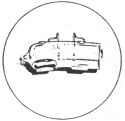
The SURGE Fencer has an indicator light which flashes with every rotation, or
once every second, for indicating short circuits on the fence line.
The SURGE Fencer has lightning arrestors specially designed and adjusted,
built into the A.C. Fencer, both on the power line side and the fence line side,
which reduces the possibility of damage from lightning to a minimum.
The SURGE A.C. Fencer sends out a current of 1000 volts, which is enough to
stop stock in the driest summer weather. The amperage is reduced to 25
milliamperes, or 1/40th of an ampere, for safety, and the current flows onto the
fence wire at intervals of one second -- 1/10th of a second "on", and
9/10ths of a second "off". This complies with the Wisconsin Code --
the SURGE Fencer is both Safe and Effective.
The SURGE A.C. Fencer meets all the qualifications of a good Fence
Controller, and it will deliver satisfactory Stock Control over a long period of
tine, if it is connected to a Good Ground and a Good Fence Line.
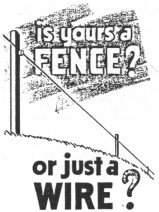
| 